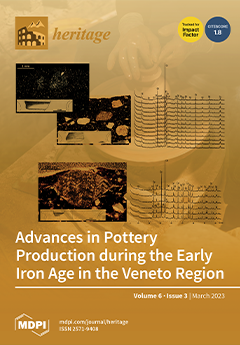This paper presents the results of the characterisation, identification, provenance determination, and quantification of the white,
greco scritto-like and polychrome marbles used for architectural purposes at
Forum Sempronii, a Roman town in the Marche region of Italy. Samples of five fragments
[...] Read more.
This paper presents the results of the characterisation, identification, provenance determination, and quantification of the white,
greco scritto-like and polychrome marbles used for architectural purposes at
Forum Sempronii, a Roman town in the Marche region of Italy. Samples of five fragments of white marble and one fragment of a
greco scritto-like marble have been studied using mineralogical and petrographic observations and stable isotope ratio analysis (SIRA) of carbon and oxygen. Polychrome marbles were macroscopically identified by comparison with reference samples and available image databases. Analytical results of the white and
greco scritto-like marbles identified the material as coming from the quarries of Carrara (Luni, Italy) and Proconnesos (Marmara, Saraylar, Turkey) for white marble, and of Ephesos-Hasançavuslar for
greco scritto-like marble. Further, at least eleven imported polychrome stone varieties were distinguished. The study clearly illustrates that
Forum Sempronii had access to the main marble trade networks of the Roman Mediterranean. The early attestation of Proconnesian marble at the town’s augusteum (i.e., Augustan date) is unique for central Adriatic Italy.
Full article





